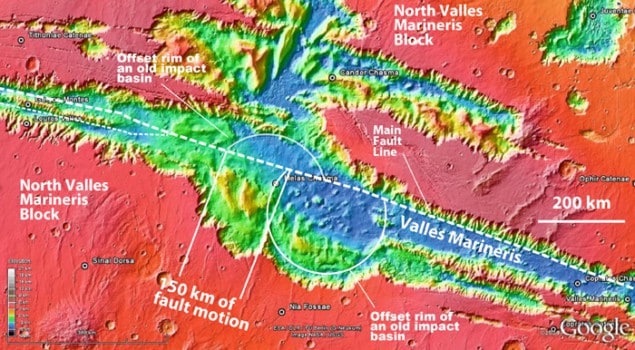
A geologist in the US claims to have found the first strong evidence for plate tectonics on Mars by studying satellite images of a huge trough in the Martian surface. It had been thought, until now, that tectonic movements were only present on Earth.
An Yin, professor of geology at the University of California, Los Angeles, spotted the tectonic activity in Valles Marineris – a 4000-km-long canyon system named after the Mariner 9 Mars orbiter that discovered the system in the 1970s. Valles Marineris stretches one-fifth of the way round the Martian surface and reaches depths of up to 7 km. The Earth’s 1.6-km-deep Grand Canyon is a mere surface scratch in comparison.
The formation of Valles Marineris is still not understood despite four decades of research. The most widely accepted theory is that spreading apart of the Martian surface created the system, similar to how rift valleys form on Earth, with the resulting crack being deepened by erosion. But Yin has now found evidence for a completely different process.
Looking for clues
Yin made use of high-resolution images taken by several Mars orbiters, including NASA’s Mars Odyssey and Mars Reconnaissance Orbiter. He focused particularly on the southern region of Valles Marineris, where a 2400-km-long trough connects three large canyons: the Ius, Melas and Coprates Chasmata. He painstakingly trawled through these images to look for “kinematic indicators” on the Martian surface – marks that reveal how the crust has moved. He discovered faults in the Ius Melas Coprates trough with a consistent, slanted orientation, which indicates a horizontal, shearing motion. He also noticed “headless” landslips at the bottom of the trough – that is, landslips without any traceable source, possibly caused by a horizontal movement of the crust since the landslips occurred.
Furthermore, Valles Marineris is exceptionally long and straight. “On Earth, there is only one kind of fault that can make a very straight and linear trace,” says Yin, “and that’s a ‘strike-slip’ fault – a fault that’s moving horizontally over a very large distance.” He also adds that the rocks on both sides of Valles Marineris are extremely flat, whereas rocks near a rift tend to be tilted.
California on Mars
Yin studied the offsets of three surface features around the fault zone to estimate the magnitude of the slip. All three measurements gave roughly the same value – 150 km – for the total distance moved by the fault. By comparison, the San Andreas Fault in California has moved around 300 km, meaning that, when scaled by the planets’ radii, the two faults are similar (the radius of Earth is around twice that of Mars).
All of Yin’s evidence points to a strike-slip system at a plate boundary, otherwise known as a transform fault. “If you have rigid blocks on the lithosphere of a planet that move horizontally over a large distance, then that’s plate tectonics,” says Yin. He names the two plates “Valles Marineris North” and “Valles Marineris South”.
“Clearly, if the reconstruction is right, this is a large transform fault,” says Norm Sleep, professor of geophysics at Stanford University. Sleep also comments that the fault should have “a net subduction effect at one end and a net spreading effect at the other”.
“The eastern end is a ‘spreading centre’ without eruption of volcanic rocks,” Yin confirms, “whereas the western end is an extensional zone filled with volcanic rocks.”
Primitive tectonics
Yin believes that the Valles Marineris fault zone is still active today but that tremors – or “Marsquakes” – are likely to be rare occurrences. “If our history of Mars is correct, everything has evolved very slowly, tectonically,” he says, “so the fault found in Valles Marineris may wake up once every million years.”
This slow geological pace may explain why the red planet is at a primitive stage of plate tectonics compared with the Earth. Yin notes that the plate-tectonic activity on Mars is localized, covering only around 20–25% of the Martian surface – the rest of Mars reveals no signs of tectonic activity.
So why do Earth and Mars have plate tectonics but not Mercury and Venus? Yin thinks that this is related to the density of a planet’s crust during its early formation, which would determine whether fractured pieces of crust could subduct into the underlying mantle. He hopes to publish this hypothesis in a future paper.
The research is described in Lithosphere.



